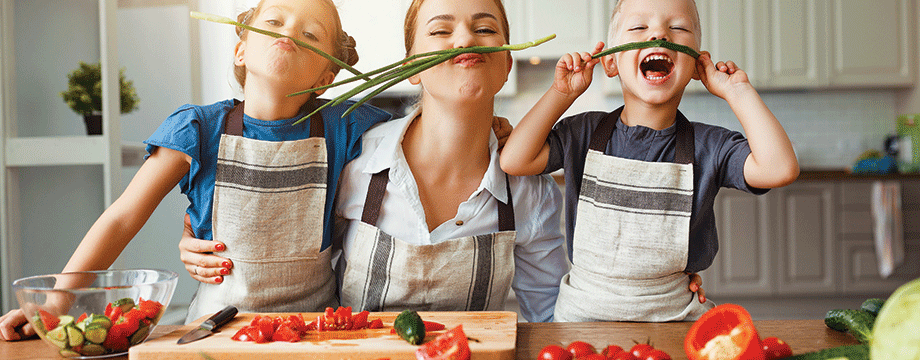Let’s hear it for kids!

Children are instinctive, interested in the world and great fun to be around – but they need guidance when it comes to their diet. We ask health store experts for their top kids food tips, and some activities based around food to keep them busy.
”It is really important that kids eat a variety of healthy foods," says Sian Eustace of Healing Harvest in Kinvara, Co Clare. "They need to eat from all the macro groups - protein, fat and carbohydrate. When using fats such as cold pressed oils think olive, hemp, avocado or flax for dressings, and grass-fed organic butter or fats such as coconut oil or ghee when oils need to be heated. Young children should not consume low fat foods, partly because they require the fats for energy and because low fat processed foods often have increased sugar to balance the flavour."
"Under fives are going through a rapid developmental stage of brain, muscle and body tissues," says Lucy Kerr at health store The Good Earth in Kilkenny. "So a healthy diet full of fruit and vegetables, healthy carbohydrates, fats and proteins will give them a wonderful start. They also need vitamin D for growth and development and maintenance of bones and teeth found in oily fish and eggs and sunlight; omega-3 for brain development and eye function found in oily fish and avocados; calcium for building strong bones and teeth, and for growth. Iron is vital for rapid growth and development - sources include red meat and green leafy vegetables."
"Carbohydrates should be consumed from grains such as oats or brown rice, wholegrain or sourdough bread, or fruits and vegetables," says Sian Eustace. "Protein is vital for growth and energy production - it is easily sourced from meat, fish and dairy but can also be obtained from nuts, pulses and wholegrains. Children should be encouraged to ‘eat the rainbow’ of fruits and vegetables. Children also need calcium, and organic dairy foods can be a good source of this. Other sources are green leafy vegetables, almonds, sesame seeds, tahini and molasses. A key concept when feeding children is to avoid processed foods where possible and to cook as much as possible from scratch."
"As children enter the teenage years vitamin B6 and zinc become necessary for hormone production, mood balance and skin health," says Lucy Kerr. "Bone development goes through a rapid change with increasing demand for vitamin D, magnesium, phosphorus and calcium. Iron requirements increase for girls after menstruation starts. Iron is also vital for cognitive function and healthy energy; B vitamins are important for mood, brain function and stress."
Children at home
"Now that children are more based from home it’s a great way to start teaching them about food and where it comes from," says Lucy Kerr. "Get them to help out with growing some low maintenance vegetables or herbs. Courgettes, tomatoes, cucumbers and beetroot grow well in plant pots during the summer. Growing some herbs on your windowsill is also a simple way to get them involved. Chives, parsely, dill and basil are very low maintenance. The easiest way to eat seasonally is to buy local or visit your local farmers' market. Bringing your child with you is a great way to show them all the delicious fruit and vegetables that are in season, allowing them to pick something of their choice to help cook with you at home."
"Why not get your child involved in growing some vegetables as they will be more inclined to try things they have grown," says Sian Eustace. "Peas are fun to watch growing and pick. Their natural sweetness is often a real winner - in our house, they rarely make it further than the door of the polytunnel before they are eaten. Try to provide a variety of textures, colours and flavours and don't push having to finish something. Trying foods is very important and remember that it can take 10-15 times of trying a food before a child will like it."
Fun with food
"Involve children in cooking from a young age," says Sian Eustace. "There are many solutions to help children to stand safely at a counter and there are great knives such as the Kiddies Food Kutter which allow children to chop all types of foods safely. Children should help to prepare meals as well as being involved in baking and should be encouraged to taste the different ingredients so that they can come to understand the different flavours.
"A good activity is to go foraging for berries and helping make some jam with the produce," says Lucy Kerr. "It's a lovely way to get some fresh air too!"
"For older children, find a children's cookbook and let them at it," says Sian Eustace. "If they have been involved in food preparation from a young age, teenagers will often continue on in a similar vein. If they haven't been involved before, or have lost interest, they can often be enticed back in by understanding the way that diet affects things such as skin health. For those who are sporty, try bringing it back to the various levels of energy and stamina they can attain from the different foods they eat."
"There are lots of cookery shows on TV nowadays," says Lucy Kerr. "Why not get your teenagers involved in a fun family bake-off or blind taste test. There are also lots of free cookery demonstrations online."
More Rude Health articles...
Articles from our latest issue...